Poverty and Housing: Theories, Causes, and Government Actions
VerifiedAdded on 2021/04/22
|16
|4281
|48
Essay
AI Summary
This essay delves into the intertwined issues of poverty and housing, examining their causes, impacts, and potential solutions within the context of the United Kingdom. It begins by defining poverty, distinguishing between absolute and relative poverty, and exploring its multifaceted nature. The essay then analyzes the causes of poverty through the lenses of contrasting theories, including the New Right and Marxist perspectives, highlighting factors such as single parenthood, unequal distribution of wealth, and individual versus structural determinants. Furthermore, it examines current government strategies aimed at alleviating poverty, such as social justice initiatives, economic diversification, redistribution policies, and foreign aid. The essay also identifies contemporary strategies for remedial actions, emphasizing the role of higher education, the impact of economic recession, and various approaches to address poverty at different levels. The analysis incorporates statistical data and theoretical frameworks to provide a comprehensive understanding of the complexities surrounding poverty and housing challenges, along with their implications for individuals and society as a whole.
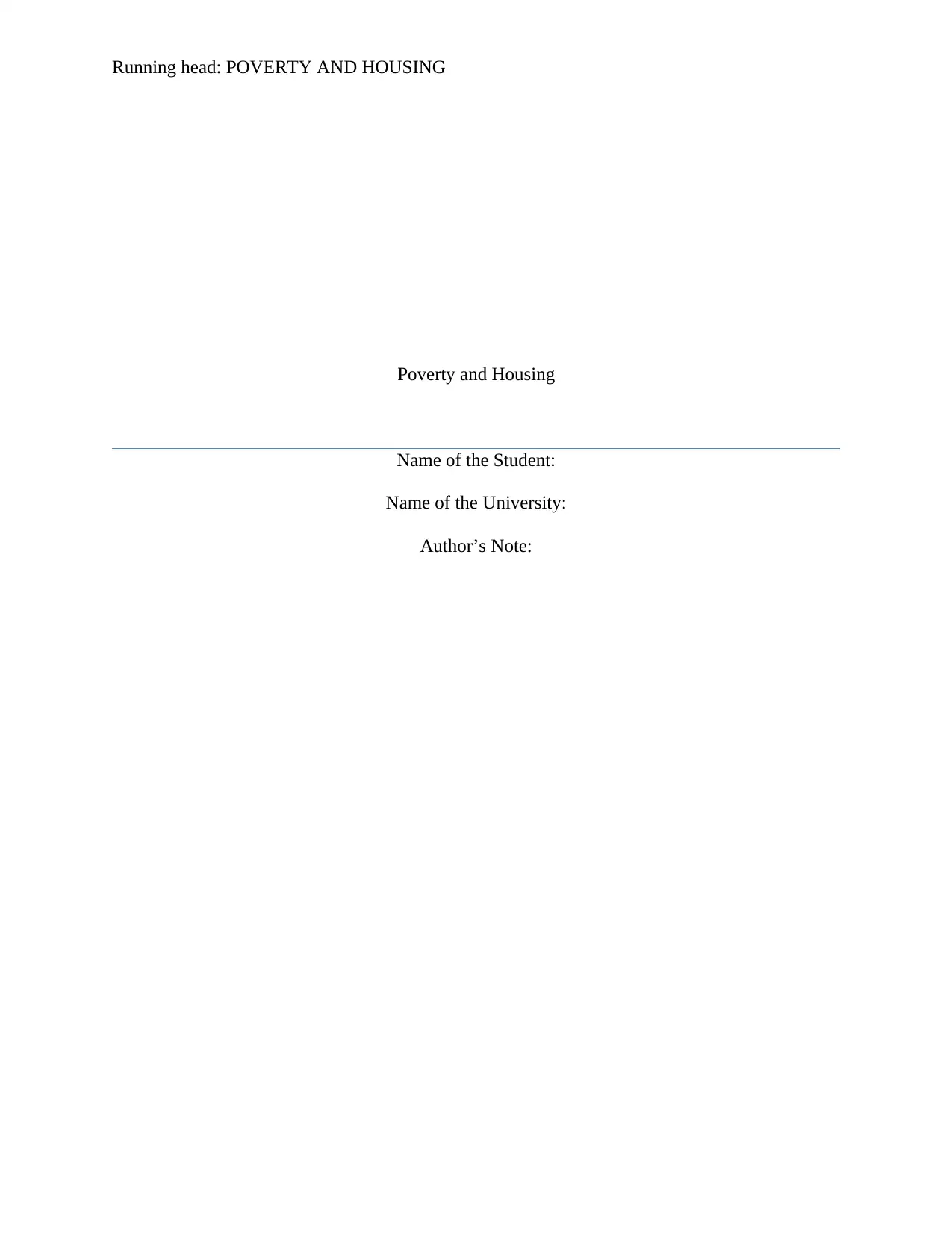
Running head: POVERTY AND HOUSING
Poverty and Housing
Name of the Student:
Name of the University:
Author’s Note:
Poverty and Housing
Name of the Student:
Name of the University:
Author’s Note:
Paraphrase This Document
Need a fresh take? Get an instant paraphrase of this document with our AI Paraphraser
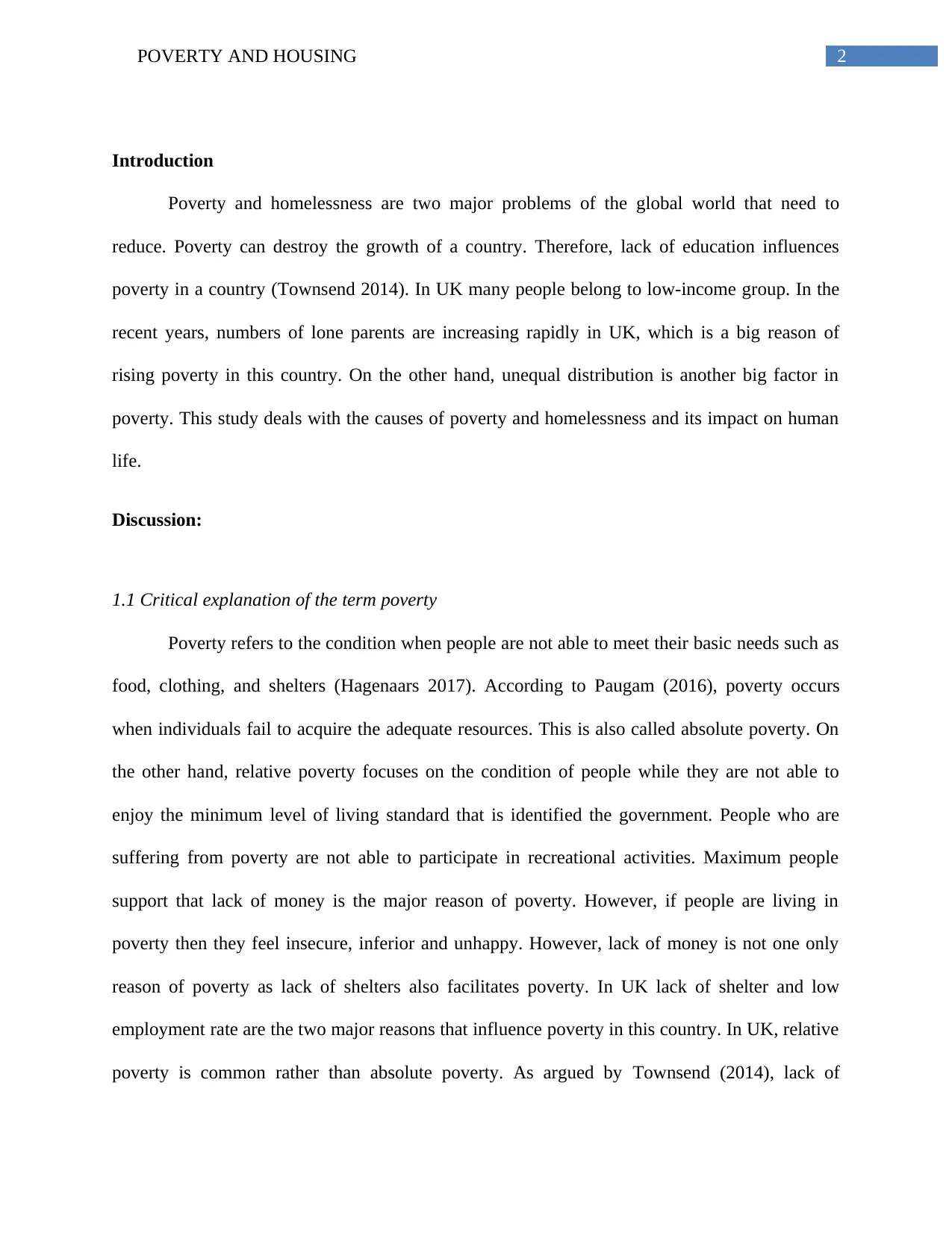
2POVERTY AND HOUSING
Introduction
Poverty and homelessness are two major problems of the global world that need to
reduce. Poverty can destroy the growth of a country. Therefore, lack of education influences
poverty in a country (Townsend 2014). In UK many people belong to low-income group. In the
recent years, numbers of lone parents are increasing rapidly in UK, which is a big reason of
rising poverty in this country. On the other hand, unequal distribution is another big factor in
poverty. This study deals with the causes of poverty and homelessness and its impact on human
life.
Discussion:
1.1 Critical explanation of the term poverty
Poverty refers to the condition when people are not able to meet their basic needs such as
food, clothing, and shelters (Hagenaars 2017). According to Paugam (2016), poverty occurs
when individuals fail to acquire the adequate resources. This is also called absolute poverty. On
the other hand, relative poverty focuses on the condition of people while they are not able to
enjoy the minimum level of living standard that is identified the government. People who are
suffering from poverty are not able to participate in recreational activities. Maximum people
support that lack of money is the major reason of poverty. However, if people are living in
poverty then they feel insecure, inferior and unhappy. However, lack of money is not one only
reason of poverty as lack of shelters also facilitates poverty. In UK lack of shelter and low
employment rate are the two major reasons that influence poverty in this country. In UK, relative
poverty is common rather than absolute poverty. As argued by Townsend (2014), lack of
Introduction
Poverty and homelessness are two major problems of the global world that need to
reduce. Poverty can destroy the growth of a country. Therefore, lack of education influences
poverty in a country (Townsend 2014). In UK many people belong to low-income group. In the
recent years, numbers of lone parents are increasing rapidly in UK, which is a big reason of
rising poverty in this country. On the other hand, unequal distribution is another big factor in
poverty. This study deals with the causes of poverty and homelessness and its impact on human
life.
Discussion:
1.1 Critical explanation of the term poverty
Poverty refers to the condition when people are not able to meet their basic needs such as
food, clothing, and shelters (Hagenaars 2017). According to Paugam (2016), poverty occurs
when individuals fail to acquire the adequate resources. This is also called absolute poverty. On
the other hand, relative poverty focuses on the condition of people while they are not able to
enjoy the minimum level of living standard that is identified the government. People who are
suffering from poverty are not able to participate in recreational activities. Maximum people
support that lack of money is the major reason of poverty. However, if people are living in
poverty then they feel insecure, inferior and unhappy. However, lack of money is not one only
reason of poverty as lack of shelters also facilitates poverty. In UK lack of shelter and low
employment rate are the two major reasons that influence poverty in this country. In UK, relative
poverty is common rather than absolute poverty. As argued by Townsend (2014), lack of
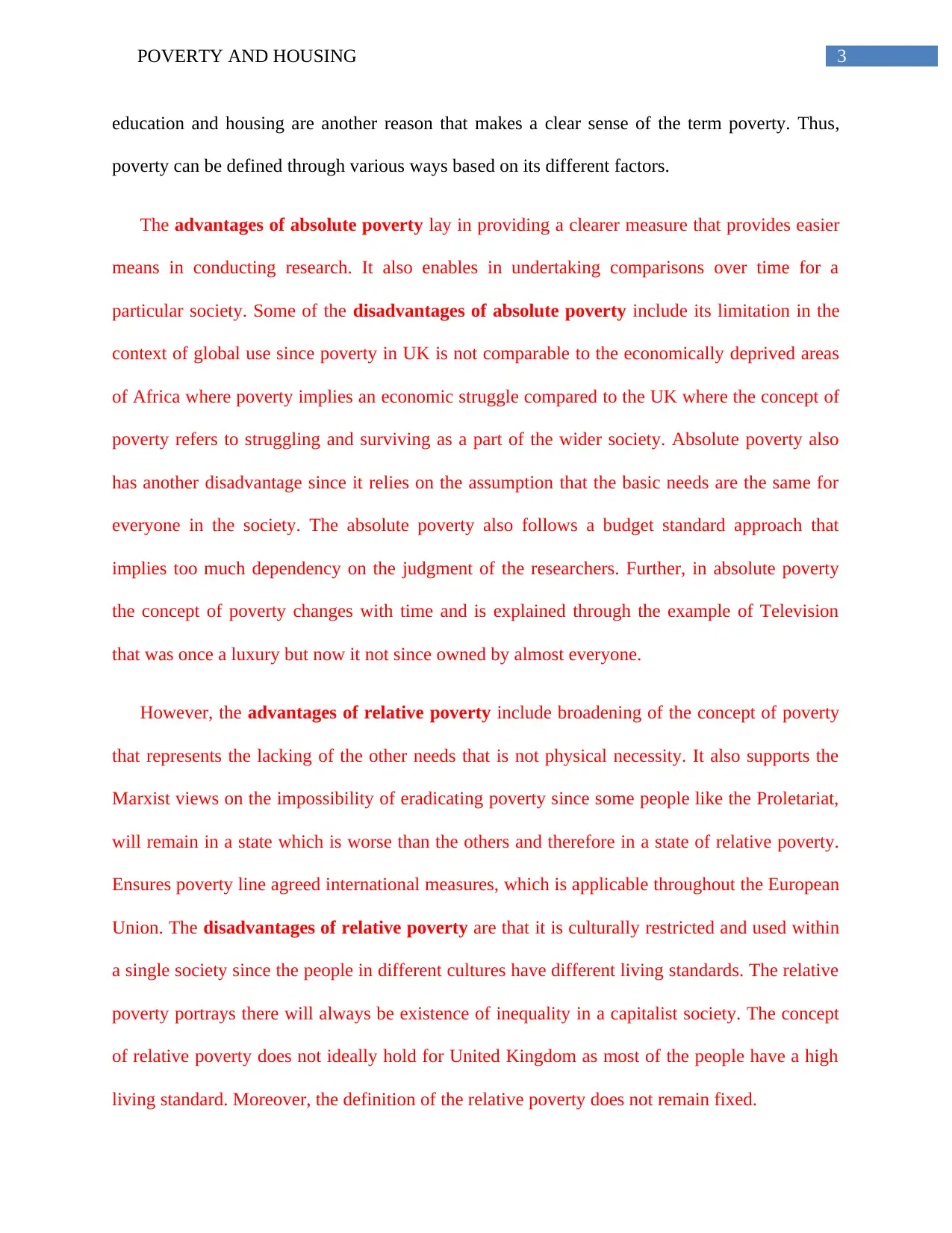
3POVERTY AND HOUSING
education and housing are another reason that makes a clear sense of the term poverty. Thus,
poverty can be defined through various ways based on its different factors.
The advantages of absolute poverty lay in providing a clearer measure that provides easier
means in conducting research. It also enables in undertaking comparisons over time for a
particular society. Some of the disadvantages of absolute poverty include its limitation in the
context of global use since poverty in UK is not comparable to the economically deprived areas
of Africa where poverty implies an economic struggle compared to the UK where the concept of
poverty refers to struggling and surviving as a part of the wider society. Absolute poverty also
has another disadvantage since it relies on the assumption that the basic needs are the same for
everyone in the society. The absolute poverty also follows a budget standard approach that
implies too much dependency on the judgment of the researchers. Further, in absolute poverty
the concept of poverty changes with time and is explained through the example of Television
that was once a luxury but now it not since owned by almost everyone.
However, the advantages of relative poverty include broadening of the concept of poverty
that represents the lacking of the other needs that is not physical necessity. It also supports the
Marxist views on the impossibility of eradicating poverty since some people like the Proletariat,
will remain in a state which is worse than the others and therefore in a state of relative poverty.
Ensures poverty line agreed international measures, which is applicable throughout the European
Union. The disadvantages of relative poverty are that it is culturally restricted and used within
a single society since the people in different cultures have different living standards. The relative
poverty portrays there will always be existence of inequality in a capitalist society. The concept
of relative poverty does not ideally hold for United Kingdom as most of the people have a high
living standard. Moreover, the definition of the relative poverty does not remain fixed.
education and housing are another reason that makes a clear sense of the term poverty. Thus,
poverty can be defined through various ways based on its different factors.
The advantages of absolute poverty lay in providing a clearer measure that provides easier
means in conducting research. It also enables in undertaking comparisons over time for a
particular society. Some of the disadvantages of absolute poverty include its limitation in the
context of global use since poverty in UK is not comparable to the economically deprived areas
of Africa where poverty implies an economic struggle compared to the UK where the concept of
poverty refers to struggling and surviving as a part of the wider society. Absolute poverty also
has another disadvantage since it relies on the assumption that the basic needs are the same for
everyone in the society. The absolute poverty also follows a budget standard approach that
implies too much dependency on the judgment of the researchers. Further, in absolute poverty
the concept of poverty changes with time and is explained through the example of Television
that was once a luxury but now it not since owned by almost everyone.
However, the advantages of relative poverty include broadening of the concept of poverty
that represents the lacking of the other needs that is not physical necessity. It also supports the
Marxist views on the impossibility of eradicating poverty since some people like the Proletariat,
will remain in a state which is worse than the others and therefore in a state of relative poverty.
Ensures poverty line agreed international measures, which is applicable throughout the European
Union. The disadvantages of relative poverty are that it is culturally restricted and used within
a single society since the people in different cultures have different living standards. The relative
poverty portrays there will always be existence of inequality in a capitalist society. The concept
of relative poverty does not ideally hold for United Kingdom as most of the people have a high
living standard. Moreover, the definition of the relative poverty does not remain fixed.
⊘ This is a preview!⊘
Do you want full access?
Subscribe today to unlock all pages.

Trusted by 1+ million students worldwide
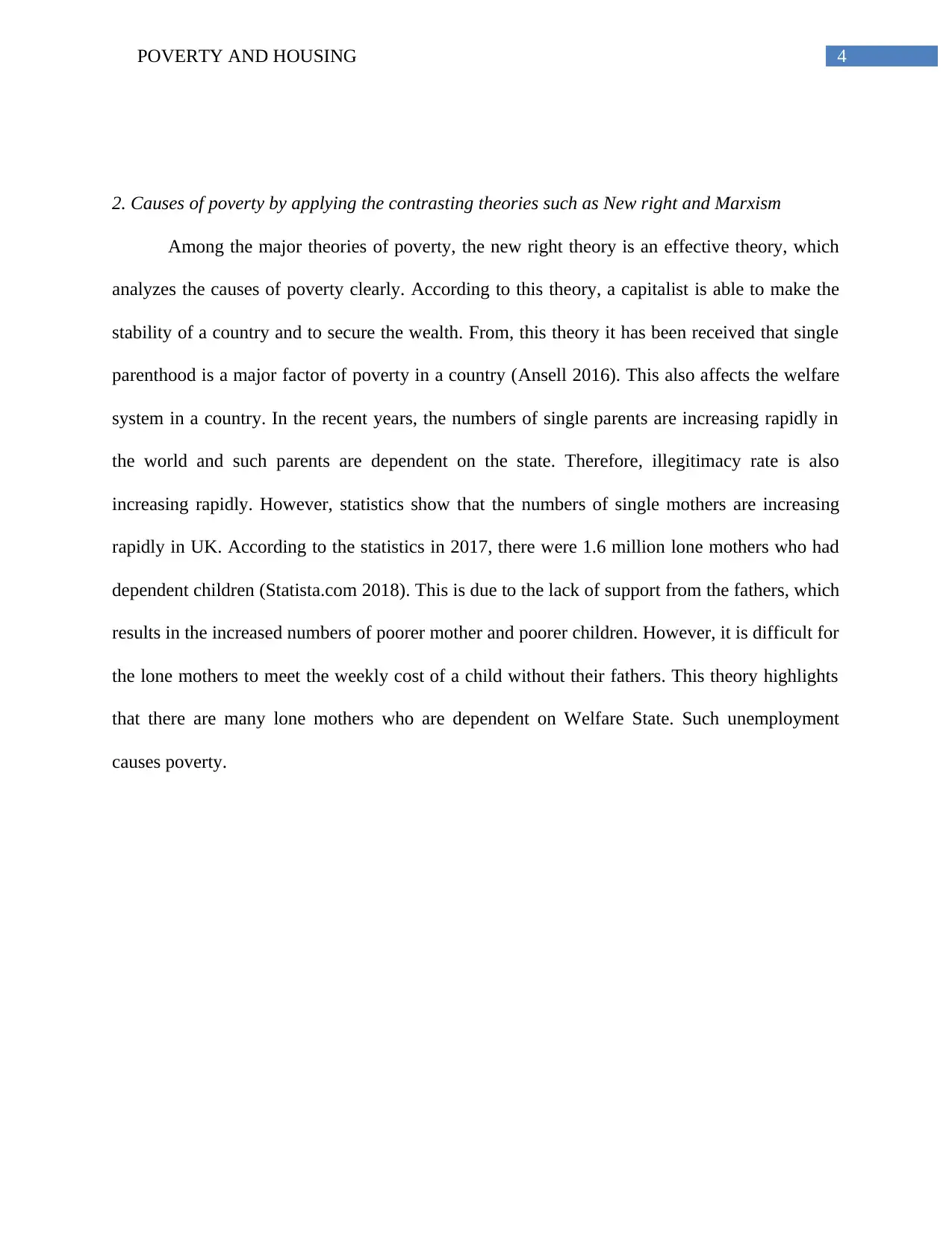
4POVERTY AND HOUSING
2. Causes of poverty by applying the contrasting theories such as New right and Marxism
Among the major theories of poverty, the new right theory is an effective theory, which
analyzes the causes of poverty clearly. According to this theory, a capitalist is able to make the
stability of a country and to secure the wealth. From, this theory it has been received that single
parenthood is a major factor of poverty in a country (Ansell 2016). This also affects the welfare
system in a country. In the recent years, the numbers of single parents are increasing rapidly in
the world and such parents are dependent on the state. Therefore, illegitimacy rate is also
increasing rapidly. However, statistics show that the numbers of single mothers are increasing
rapidly in UK. According to the statistics in 2017, there were 1.6 million lone mothers who had
dependent children (Statista.com 2018). This is due to the lack of support from the fathers, which
results in the increased numbers of poorer mother and poorer children. However, it is difficult for
the lone mothers to meet the weekly cost of a child without their fathers. This theory highlights
that there are many lone mothers who are dependent on Welfare State. Such unemployment
causes poverty.
2. Causes of poverty by applying the contrasting theories such as New right and Marxism
Among the major theories of poverty, the new right theory is an effective theory, which
analyzes the causes of poverty clearly. According to this theory, a capitalist is able to make the
stability of a country and to secure the wealth. From, this theory it has been received that single
parenthood is a major factor of poverty in a country (Ansell 2016). This also affects the welfare
system in a country. In the recent years, the numbers of single parents are increasing rapidly in
the world and such parents are dependent on the state. Therefore, illegitimacy rate is also
increasing rapidly. However, statistics show that the numbers of single mothers are increasing
rapidly in UK. According to the statistics in 2017, there were 1.6 million lone mothers who had
dependent children (Statista.com 2018). This is due to the lack of support from the fathers, which
results in the increased numbers of poorer mother and poorer children. However, it is difficult for
the lone mothers to meet the weekly cost of a child without their fathers. This theory highlights
that there are many lone mothers who are dependent on Welfare State. Such unemployment
causes poverty.
Paraphrase This Document
Need a fresh take? Get an instant paraphrase of this document with our AI Paraphraser
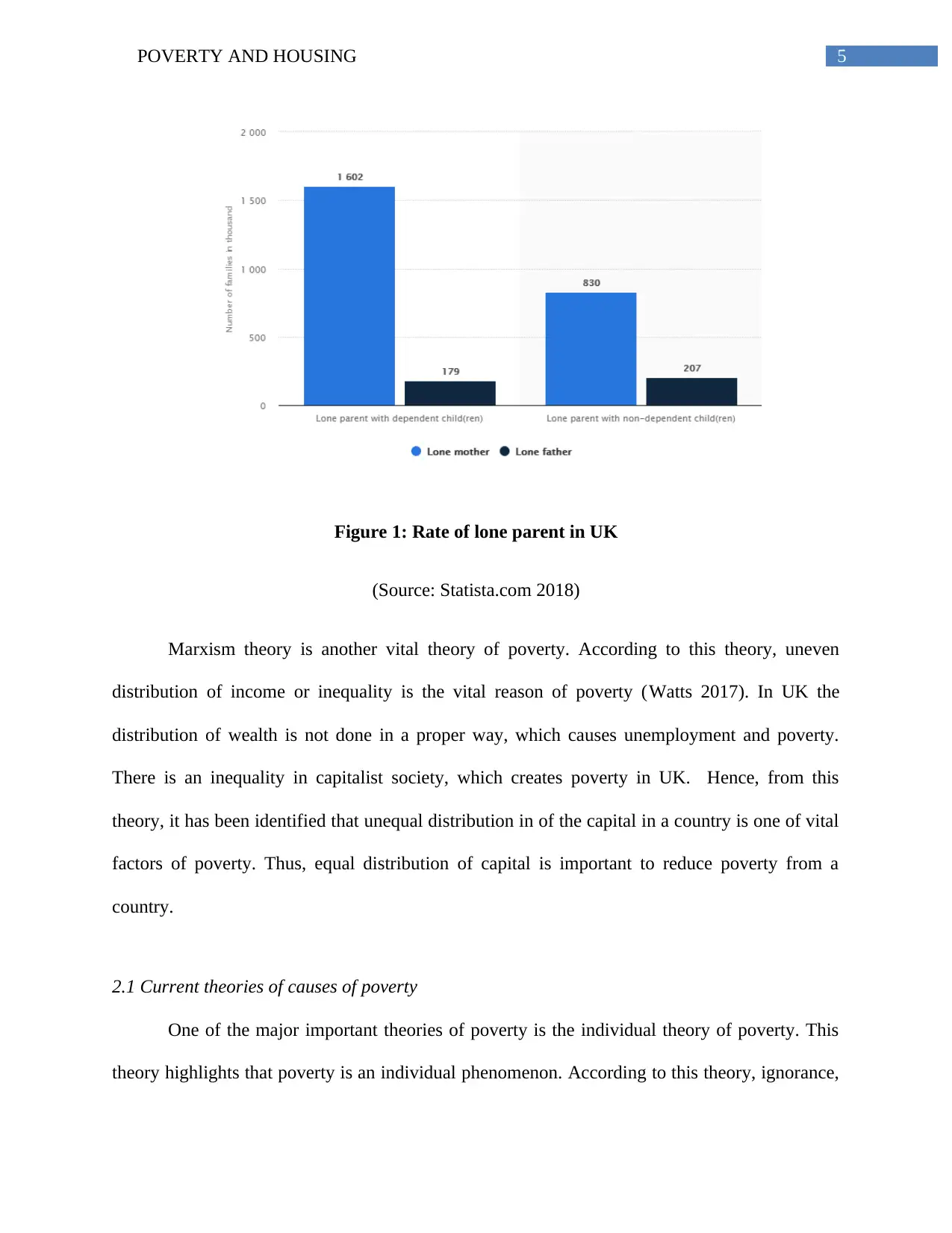
5POVERTY AND HOUSING
Figure 1: Rate of lone parent in UK
(Source: Statista.com 2018)
Marxism theory is another vital theory of poverty. According to this theory, uneven
distribution of income or inequality is the vital reason of poverty (Watts 2017). In UK the
distribution of wealth is not done in a proper way, which causes unemployment and poverty.
There is an inequality in capitalist society, which creates poverty in UK. Hence, from this
theory, it has been identified that unequal distribution in of the capital in a country is one of vital
factors of poverty. Thus, equal distribution of capital is important to reduce poverty from a
country.
2.1 Current theories of causes of poverty
One of the major important theories of poverty is the individual theory of poverty. This
theory highlights that poverty is an individual phenomenon. According to this theory, ignorance,
Figure 1: Rate of lone parent in UK
(Source: Statista.com 2018)
Marxism theory is another vital theory of poverty. According to this theory, uneven
distribution of income or inequality is the vital reason of poverty (Watts 2017). In UK the
distribution of wealth is not done in a proper way, which causes unemployment and poverty.
There is an inequality in capitalist society, which creates poverty in UK. Hence, from this
theory, it has been identified that unequal distribution in of the capital in a country is one of vital
factors of poverty. Thus, equal distribution of capital is important to reduce poverty from a
country.
2.1 Current theories of causes of poverty
One of the major important theories of poverty is the individual theory of poverty. This
theory highlights that poverty is an individual phenomenon. According to this theory, ignorance,
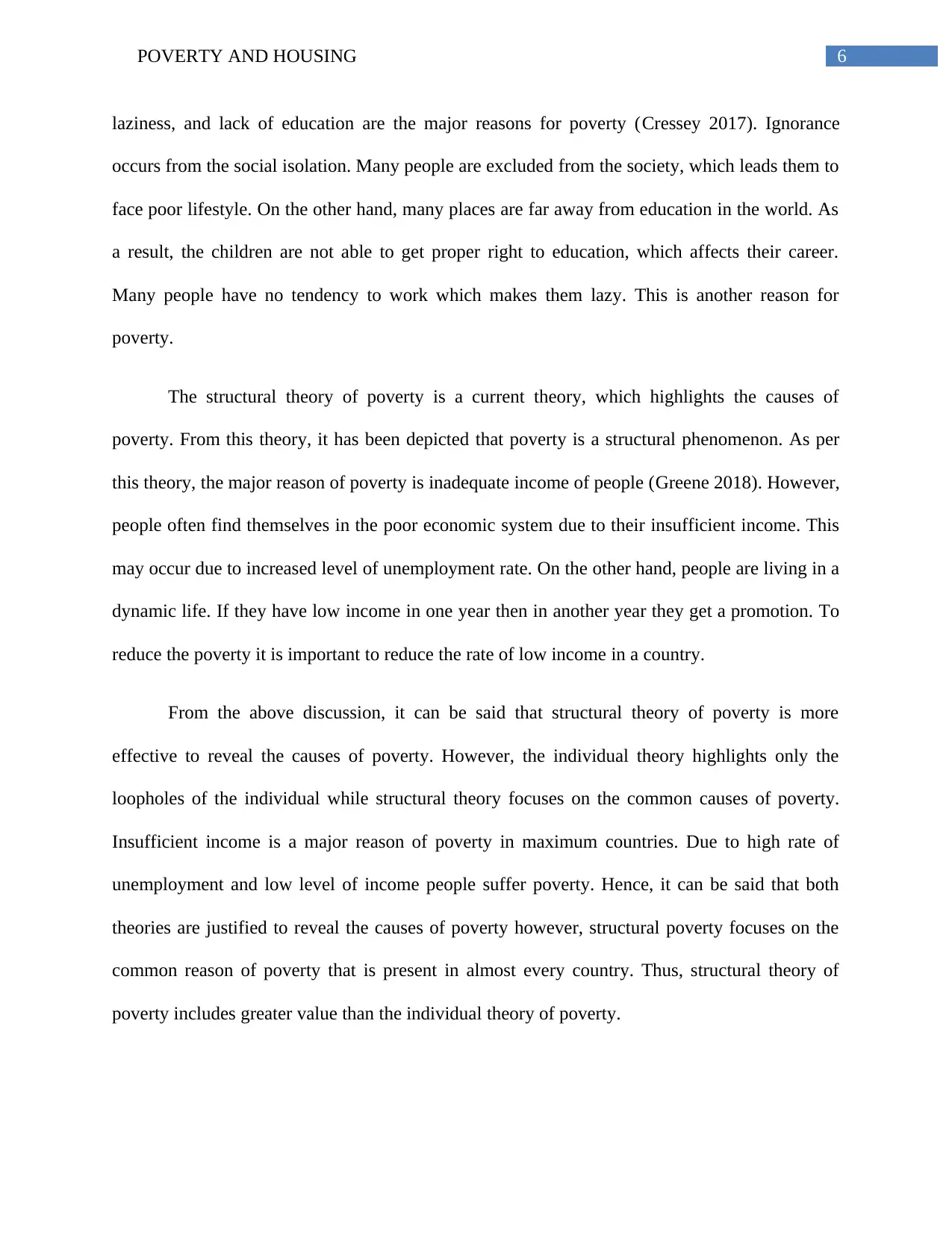
6POVERTY AND HOUSING
laziness, and lack of education are the major reasons for poverty (Cressey 2017). Ignorance
occurs from the social isolation. Many people are excluded from the society, which leads them to
face poor lifestyle. On the other hand, many places are far away from education in the world. As
a result, the children are not able to get proper right to education, which affects their career.
Many people have no tendency to work which makes them lazy. This is another reason for
poverty.
The structural theory of poverty is a current theory, which highlights the causes of
poverty. From this theory, it has been depicted that poverty is a structural phenomenon. As per
this theory, the major reason of poverty is inadequate income of people (Greene 2018). However,
people often find themselves in the poor economic system due to their insufficient income. This
may occur due to increased level of unemployment rate. On the other hand, people are living in a
dynamic life. If they have low income in one year then in another year they get a promotion. To
reduce the poverty it is important to reduce the rate of low income in a country.
From the above discussion, it can be said that structural theory of poverty is more
effective to reveal the causes of poverty. However, the individual theory highlights only the
loopholes of the individual while structural theory focuses on the common causes of poverty.
Insufficient income is a major reason of poverty in maximum countries. Due to high rate of
unemployment and low level of income people suffer poverty. Hence, it can be said that both
theories are justified to reveal the causes of poverty however, structural poverty focuses on the
common reason of poverty that is present in almost every country. Thus, structural theory of
poverty includes greater value than the individual theory of poverty.
laziness, and lack of education are the major reasons for poverty (Cressey 2017). Ignorance
occurs from the social isolation. Many people are excluded from the society, which leads them to
face poor lifestyle. On the other hand, many places are far away from education in the world. As
a result, the children are not able to get proper right to education, which affects their career.
Many people have no tendency to work which makes them lazy. This is another reason for
poverty.
The structural theory of poverty is a current theory, which highlights the causes of
poverty. From this theory, it has been depicted that poverty is a structural phenomenon. As per
this theory, the major reason of poverty is inadequate income of people (Greene 2018). However,
people often find themselves in the poor economic system due to their insufficient income. This
may occur due to increased level of unemployment rate. On the other hand, people are living in a
dynamic life. If they have low income in one year then in another year they get a promotion. To
reduce the poverty it is important to reduce the rate of low income in a country.
From the above discussion, it can be said that structural theory of poverty is more
effective to reveal the causes of poverty. However, the individual theory highlights only the
loopholes of the individual while structural theory focuses on the common causes of poverty.
Insufficient income is a major reason of poverty in maximum countries. Due to high rate of
unemployment and low level of income people suffer poverty. Hence, it can be said that both
theories are justified to reveal the causes of poverty however, structural poverty focuses on the
common reason of poverty that is present in almost every country. Thus, structural theory of
poverty includes greater value than the individual theory of poverty.
⊘ This is a preview!⊘
Do you want full access?
Subscribe today to unlock all pages.

Trusted by 1+ million students worldwide
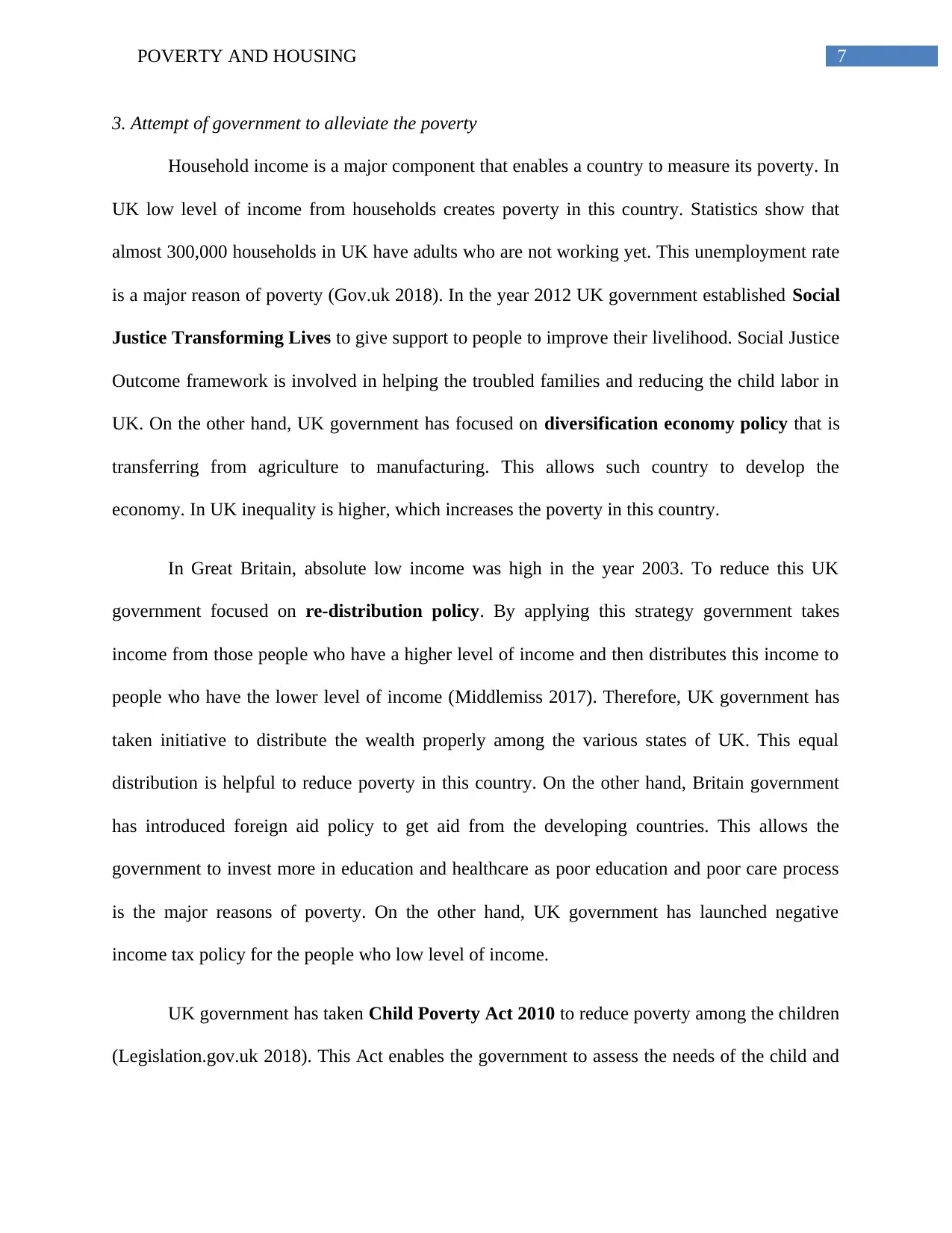
7POVERTY AND HOUSING
3. Attempt of government to alleviate the poverty
Household income is a major component that enables a country to measure its poverty. In
UK low level of income from households creates poverty in this country. Statistics show that
almost 300,000 households in UK have adults who are not working yet. This unemployment rate
is a major reason of poverty (Gov.uk 2018). In the year 2012 UK government established Social
Justice Transforming Lives to give support to people to improve their livelihood. Social Justice
Outcome framework is involved in helping the troubled families and reducing the child labor in
UK. On the other hand, UK government has focused on diversification economy policy that is
transferring from agriculture to manufacturing. This allows such country to develop the
economy. In UK inequality is higher, which increases the poverty in this country.
In Great Britain, absolute low income was high in the year 2003. To reduce this UK
government focused on re-distribution policy. By applying this strategy government takes
income from those people who have a higher level of income and then distributes this income to
people who have the lower level of income (Middlemiss 2017). Therefore, UK government has
taken initiative to distribute the wealth properly among the various states of UK. This equal
distribution is helpful to reduce poverty in this country. On the other hand, Britain government
has introduced foreign aid policy to get aid from the developing countries. This allows the
government to invest more in education and healthcare as poor education and poor care process
is the major reasons of poverty. On the other hand, UK government has launched negative
income tax policy for the people who low level of income.
UK government has taken Child Poverty Act 2010 to reduce poverty among the children
(Legislation.gov.uk 2018). This Act enables the government to assess the needs of the child and
3. Attempt of government to alleviate the poverty
Household income is a major component that enables a country to measure its poverty. In
UK low level of income from households creates poverty in this country. Statistics show that
almost 300,000 households in UK have adults who are not working yet. This unemployment rate
is a major reason of poverty (Gov.uk 2018). In the year 2012 UK government established Social
Justice Transforming Lives to give support to people to improve their livelihood. Social Justice
Outcome framework is involved in helping the troubled families and reducing the child labor in
UK. On the other hand, UK government has focused on diversification economy policy that is
transferring from agriculture to manufacturing. This allows such country to develop the
economy. In UK inequality is higher, which increases the poverty in this country.
In Great Britain, absolute low income was high in the year 2003. To reduce this UK
government focused on re-distribution policy. By applying this strategy government takes
income from those people who have a higher level of income and then distributes this income to
people who have the lower level of income (Middlemiss 2017). Therefore, UK government has
taken initiative to distribute the wealth properly among the various states of UK. This equal
distribution is helpful to reduce poverty in this country. On the other hand, Britain government
has introduced foreign aid policy to get aid from the developing countries. This allows the
government to invest more in education and healthcare as poor education and poor care process
is the major reasons of poverty. On the other hand, UK government has launched negative
income tax policy for the people who low level of income.
UK government has taken Child Poverty Act 2010 to reduce poverty among the children
(Legislation.gov.uk 2018). This Act enables the government to assess the needs of the child and
Paraphrase This Document
Need a fresh take? Get an instant paraphrase of this document with our AI Paraphraser
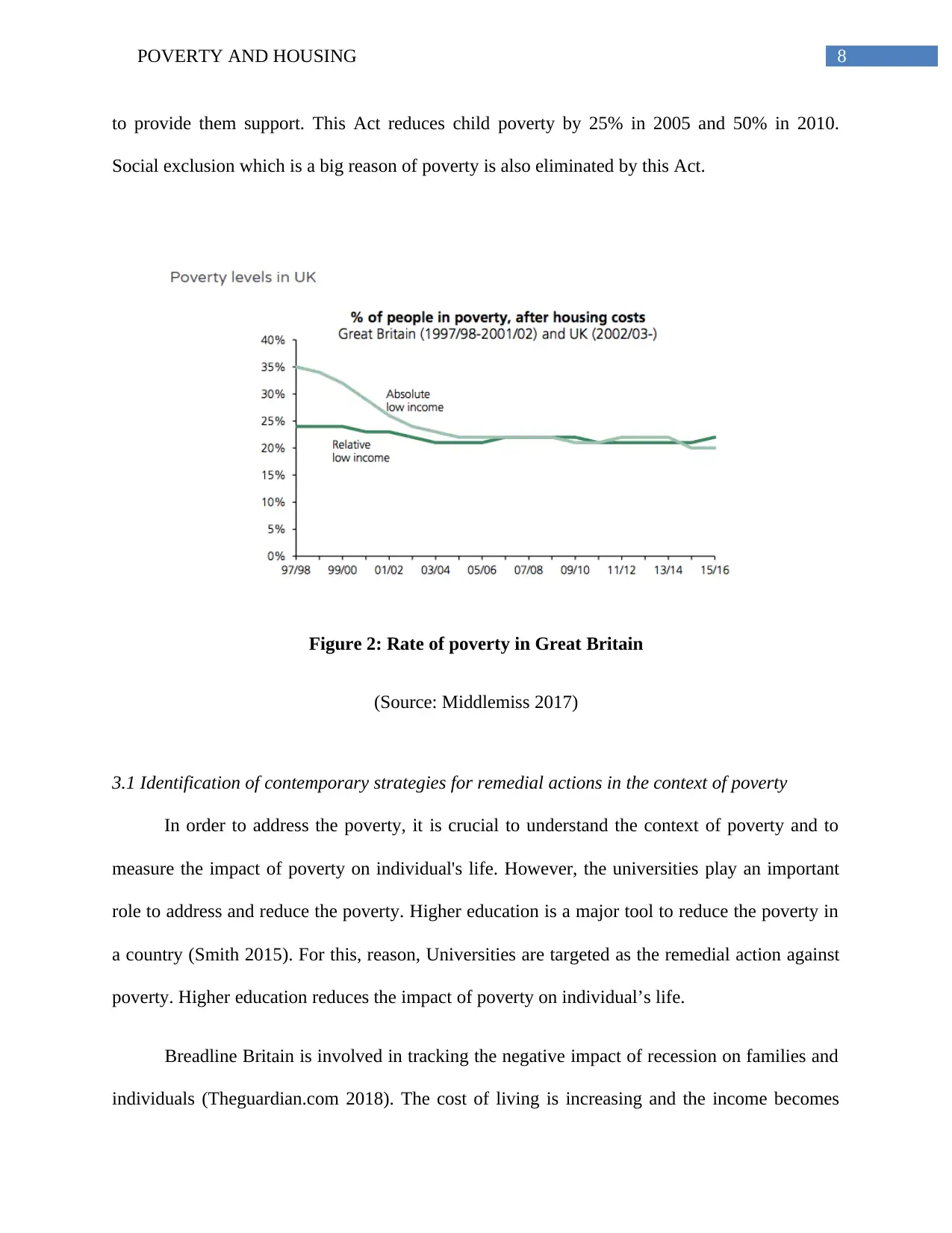
8POVERTY AND HOUSING
to provide them support. This Act reduces child poverty by 25% in 2005 and 50% in 2010.
Social exclusion which is a big reason of poverty is also eliminated by this Act.
Figure 2: Rate of poverty in Great Britain
(Source: Middlemiss 2017)
3.1 Identification of contemporary strategies for remedial actions in the context of poverty
In order to address the poverty, it is crucial to understand the context of poverty and to
measure the impact of poverty on individual's life. However, the universities play an important
role to address and reduce the poverty. Higher education is a major tool to reduce the poverty in
a country (Smith 2015). For this, reason, Universities are targeted as the remedial action against
poverty. Higher education reduces the impact of poverty on individual’s life.
Breadline Britain is involved in tracking the negative impact of recession on families and
individuals (Theguardian.com 2018). The cost of living is increasing and the income becomes
to provide them support. This Act reduces child poverty by 25% in 2005 and 50% in 2010.
Social exclusion which is a big reason of poverty is also eliminated by this Act.
Figure 2: Rate of poverty in Great Britain
(Source: Middlemiss 2017)
3.1 Identification of contemporary strategies for remedial actions in the context of poverty
In order to address the poverty, it is crucial to understand the context of poverty and to
measure the impact of poverty on individual's life. However, the universities play an important
role to address and reduce the poverty. Higher education is a major tool to reduce the poverty in
a country (Smith 2015). For this, reason, Universities are targeted as the remedial action against
poverty. Higher education reduces the impact of poverty on individual’s life.
Breadline Britain is involved in tracking the negative impact of recession on families and
individuals (Theguardian.com 2018). The cost of living is increasing and the income becomes
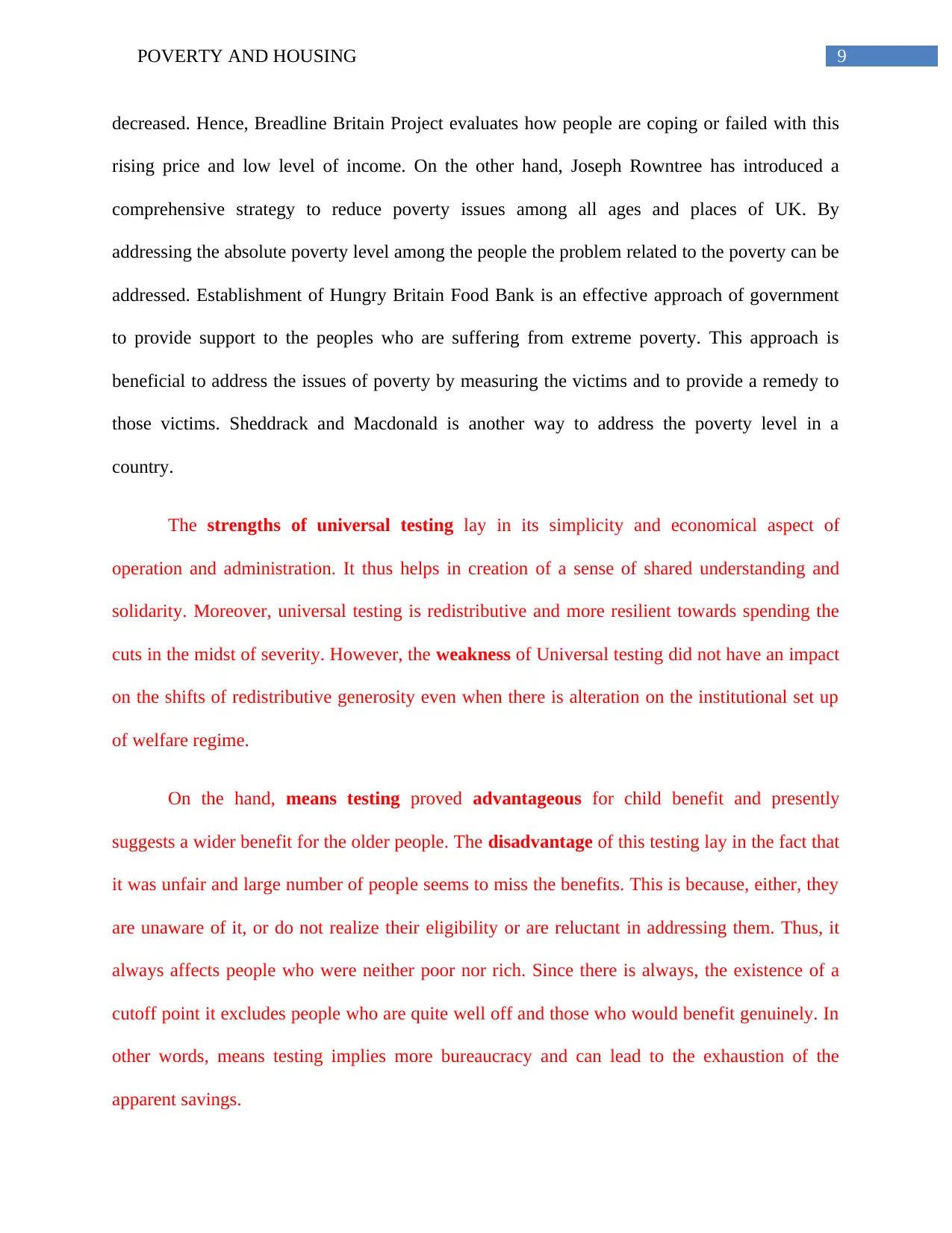
9POVERTY AND HOUSING
decreased. Hence, Breadline Britain Project evaluates how people are coping or failed with this
rising price and low level of income. On the other hand, Joseph Rowntree has introduced a
comprehensive strategy to reduce poverty issues among all ages and places of UK. By
addressing the absolute poverty level among the people the problem related to the poverty can be
addressed. Establishment of Hungry Britain Food Bank is an effective approach of government
to provide support to the peoples who are suffering from extreme poverty. This approach is
beneficial to address the issues of poverty by measuring the victims and to provide a remedy to
those victims. Sheddrack and Macdonald is another way to address the poverty level in a
country.
The strengths of universal testing lay in its simplicity and economical aspect of
operation and administration. It thus helps in creation of a sense of shared understanding and
solidarity. Moreover, universal testing is redistributive and more resilient towards spending the
cuts in the midst of severity. However, the weakness of Universal testing did not have an impact
on the shifts of redistributive generosity even when there is alteration on the institutional set up
of welfare regime.
On the hand, means testing proved advantageous for child benefit and presently
suggests a wider benefit for the older people. The disadvantage of this testing lay in the fact that
it was unfair and large number of people seems to miss the benefits. This is because, either, they
are unaware of it, or do not realize their eligibility or are reluctant in addressing them. Thus, it
always affects people who were neither poor nor rich. Since there is always, the existence of a
cutoff point it excludes people who are quite well off and those who would benefit genuinely. In
other words, means testing implies more bureaucracy and can lead to the exhaustion of the
apparent savings.
decreased. Hence, Breadline Britain Project evaluates how people are coping or failed with this
rising price and low level of income. On the other hand, Joseph Rowntree has introduced a
comprehensive strategy to reduce poverty issues among all ages and places of UK. By
addressing the absolute poverty level among the people the problem related to the poverty can be
addressed. Establishment of Hungry Britain Food Bank is an effective approach of government
to provide support to the peoples who are suffering from extreme poverty. This approach is
beneficial to address the issues of poverty by measuring the victims and to provide a remedy to
those victims. Sheddrack and Macdonald is another way to address the poverty level in a
country.
The strengths of universal testing lay in its simplicity and economical aspect of
operation and administration. It thus helps in creation of a sense of shared understanding and
solidarity. Moreover, universal testing is redistributive and more resilient towards spending the
cuts in the midst of severity. However, the weakness of Universal testing did not have an impact
on the shifts of redistributive generosity even when there is alteration on the institutional set up
of welfare regime.
On the hand, means testing proved advantageous for child benefit and presently
suggests a wider benefit for the older people. The disadvantage of this testing lay in the fact that
it was unfair and large number of people seems to miss the benefits. This is because, either, they
are unaware of it, or do not realize their eligibility or are reluctant in addressing them. Thus, it
always affects people who were neither poor nor rich. Since there is always, the existence of a
cutoff point it excludes people who are quite well off and those who would benefit genuinely. In
other words, means testing implies more bureaucracy and can lead to the exhaustion of the
apparent savings.
⊘ This is a preview!⊘
Do you want full access?
Subscribe today to unlock all pages.

Trusted by 1+ million students worldwide
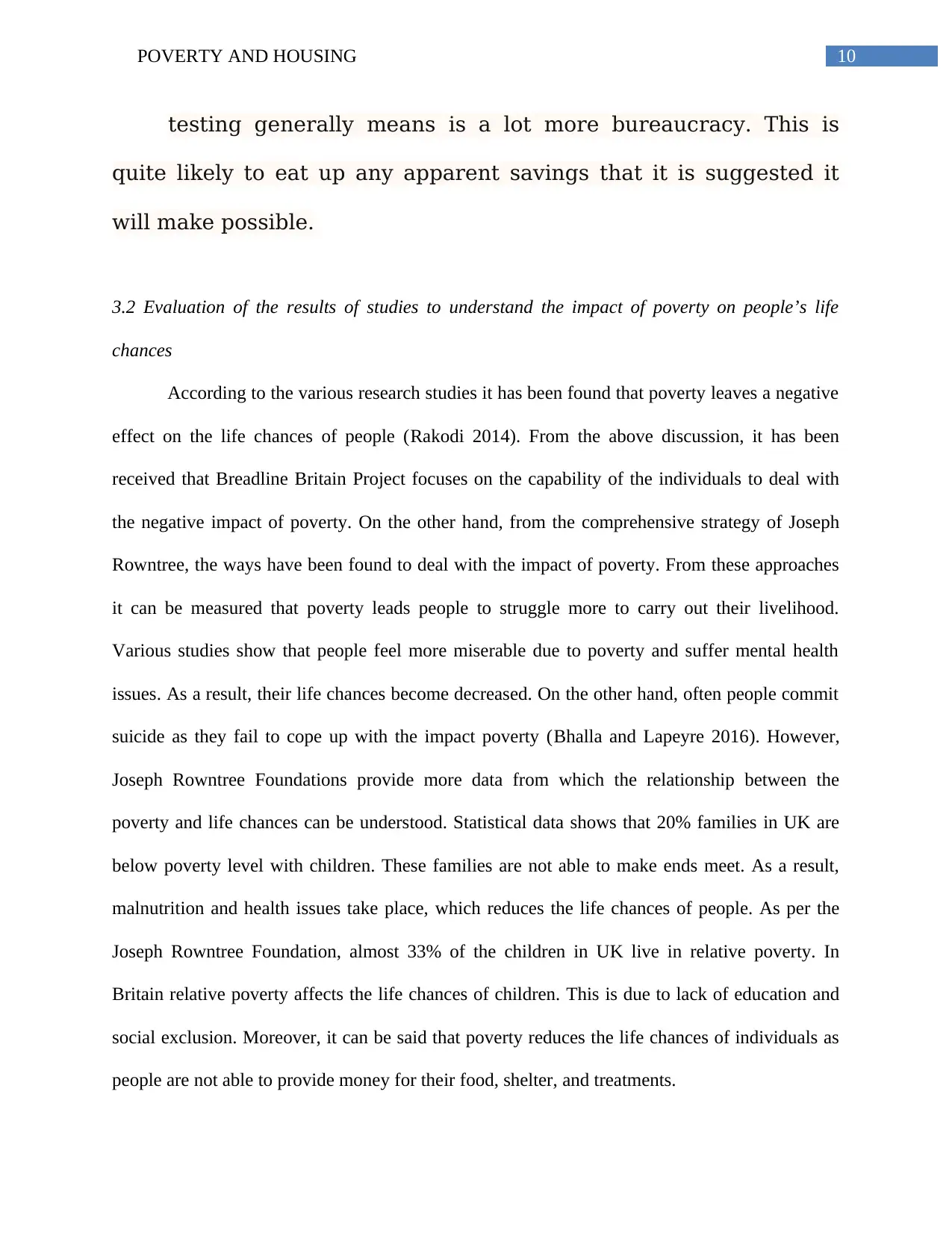
10POVERTY AND HOUSING
testing generally means is a lot more bureaucracy. This is
quite likely to eat up any apparent savings that it is suggested it
will make possible.
3.2 Evaluation of the results of studies to understand the impact of poverty on people’s life
chances
According to the various research studies it has been found that poverty leaves a negative
effect on the life chances of people (Rakodi 2014). From the above discussion, it has been
received that Breadline Britain Project focuses on the capability of the individuals to deal with
the negative impact of poverty. On the other hand, from the comprehensive strategy of Joseph
Rowntree, the ways have been found to deal with the impact of poverty. From these approaches
it can be measured that poverty leads people to struggle more to carry out their livelihood.
Various studies show that people feel more miserable due to poverty and suffer mental health
issues. As a result, their life chances become decreased. On the other hand, often people commit
suicide as they fail to cope up with the impact poverty (Bhalla and Lapeyre 2016). However,
Joseph Rowntree Foundations provide more data from which the relationship between the
poverty and life chances can be understood. Statistical data shows that 20% families in UK are
below poverty level with children. These families are not able to make ends meet. As a result,
malnutrition and health issues take place, which reduces the life chances of people. As per the
Joseph Rowntree Foundation, almost 33% of the children in UK live in relative poverty. In
Britain relative poverty affects the life chances of children. This is due to lack of education and
social exclusion. Moreover, it can be said that poverty reduces the life chances of individuals as
people are not able to provide money for their food, shelter, and treatments.
testing generally means is a lot more bureaucracy. This is
quite likely to eat up any apparent savings that it is suggested it
will make possible.
3.2 Evaluation of the results of studies to understand the impact of poverty on people’s life
chances
According to the various research studies it has been found that poverty leaves a negative
effect on the life chances of people (Rakodi 2014). From the above discussion, it has been
received that Breadline Britain Project focuses on the capability of the individuals to deal with
the negative impact of poverty. On the other hand, from the comprehensive strategy of Joseph
Rowntree, the ways have been found to deal with the impact of poverty. From these approaches
it can be measured that poverty leads people to struggle more to carry out their livelihood.
Various studies show that people feel more miserable due to poverty and suffer mental health
issues. As a result, their life chances become decreased. On the other hand, often people commit
suicide as they fail to cope up with the impact poverty (Bhalla and Lapeyre 2016). However,
Joseph Rowntree Foundations provide more data from which the relationship between the
poverty and life chances can be understood. Statistical data shows that 20% families in UK are
below poverty level with children. These families are not able to make ends meet. As a result,
malnutrition and health issues take place, which reduces the life chances of people. As per the
Joseph Rowntree Foundation, almost 33% of the children in UK live in relative poverty. In
Britain relative poverty affects the life chances of children. This is due to lack of education and
social exclusion. Moreover, it can be said that poverty reduces the life chances of individuals as
people are not able to provide money for their food, shelter, and treatments.
Paraphrase This Document
Need a fresh take? Get an instant paraphrase of this document with our AI Paraphraser
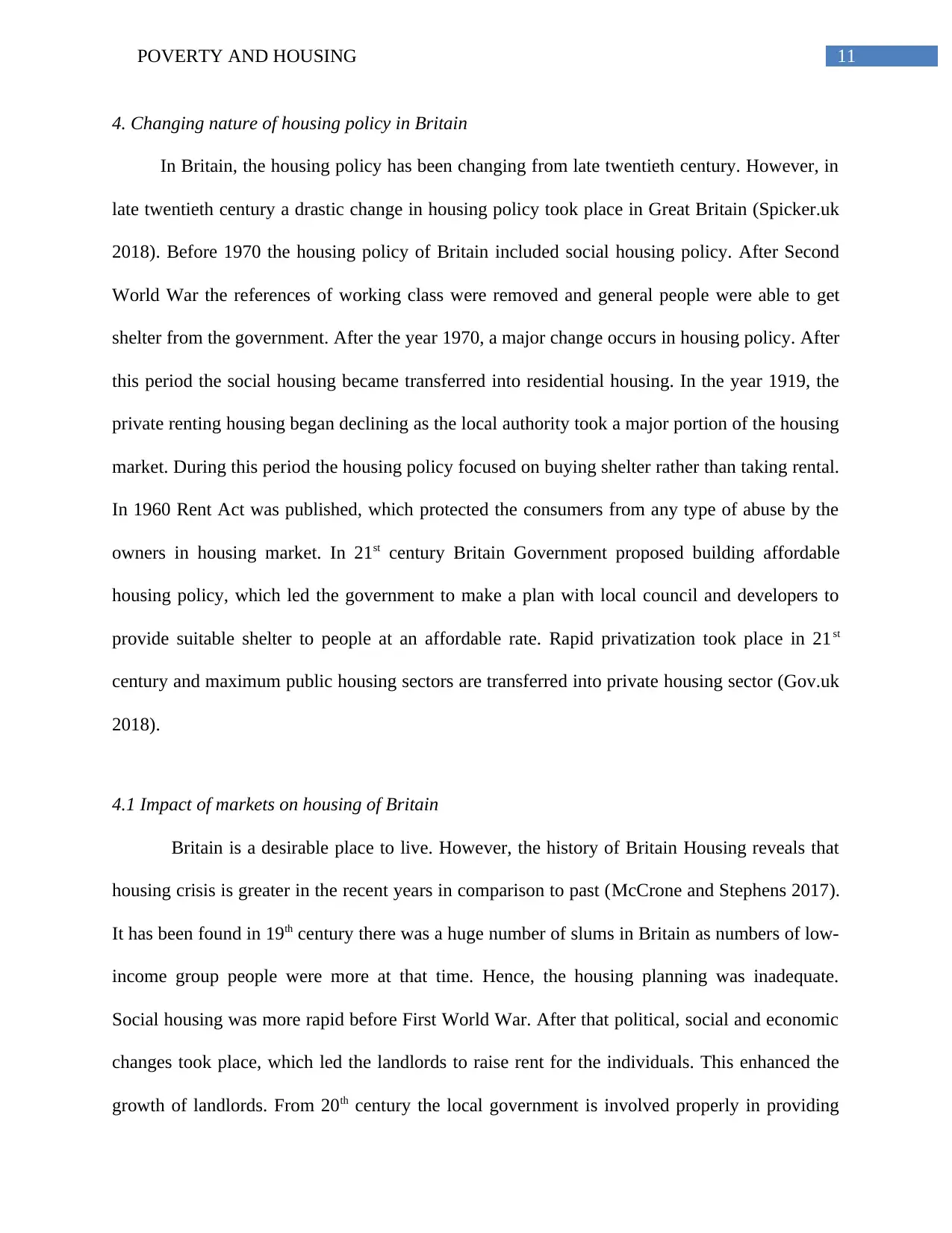
11POVERTY AND HOUSING
4. Changing nature of housing policy in Britain
In Britain, the housing policy has been changing from late twentieth century. However, in
late twentieth century a drastic change in housing policy took place in Great Britain (Spicker.uk
2018). Before 1970 the housing policy of Britain included social housing policy. After Second
World War the references of working class were removed and general people were able to get
shelter from the government. After the year 1970, a major change occurs in housing policy. After
this period the social housing became transferred into residential housing. In the year 1919, the
private renting housing began declining as the local authority took a major portion of the housing
market. During this period the housing policy focused on buying shelter rather than taking rental.
In 1960 Rent Act was published, which protected the consumers from any type of abuse by the
owners in housing market. In 21st century Britain Government proposed building affordable
housing policy, which led the government to make a plan with local council and developers to
provide suitable shelter to people at an affordable rate. Rapid privatization took place in 21st
century and maximum public housing sectors are transferred into private housing sector (Gov.uk
2018).
4.1 Impact of markets on housing of Britain
Britain is a desirable place to live. However, the history of Britain Housing reveals that
housing crisis is greater in the recent years in comparison to past (McCrone and Stephens 2017).
It has been found in 19th century there was a huge number of slums in Britain as numbers of low-
income group people were more at that time. Hence, the housing planning was inadequate.
Social housing was more rapid before First World War. After that political, social and economic
changes took place, which led the landlords to raise rent for the individuals. This enhanced the
growth of landlords. From 20th century the local government is involved properly in providing
4. Changing nature of housing policy in Britain
In Britain, the housing policy has been changing from late twentieth century. However, in
late twentieth century a drastic change in housing policy took place in Great Britain (Spicker.uk
2018). Before 1970 the housing policy of Britain included social housing policy. After Second
World War the references of working class were removed and general people were able to get
shelter from the government. After the year 1970, a major change occurs in housing policy. After
this period the social housing became transferred into residential housing. In the year 1919, the
private renting housing began declining as the local authority took a major portion of the housing
market. During this period the housing policy focused on buying shelter rather than taking rental.
In 1960 Rent Act was published, which protected the consumers from any type of abuse by the
owners in housing market. In 21st century Britain Government proposed building affordable
housing policy, which led the government to make a plan with local council and developers to
provide suitable shelter to people at an affordable rate. Rapid privatization took place in 21st
century and maximum public housing sectors are transferred into private housing sector (Gov.uk
2018).
4.1 Impact of markets on housing of Britain
Britain is a desirable place to live. However, the history of Britain Housing reveals that
housing crisis is greater in the recent years in comparison to past (McCrone and Stephens 2017).
It has been found in 19th century there was a huge number of slums in Britain as numbers of low-
income group people were more at that time. Hence, the housing planning was inadequate.
Social housing was more rapid before First World War. After that political, social and economic
changes took place, which led the landlords to raise rent for the individuals. This enhanced the
growth of landlords. From 20th century the local government is involved properly in providing
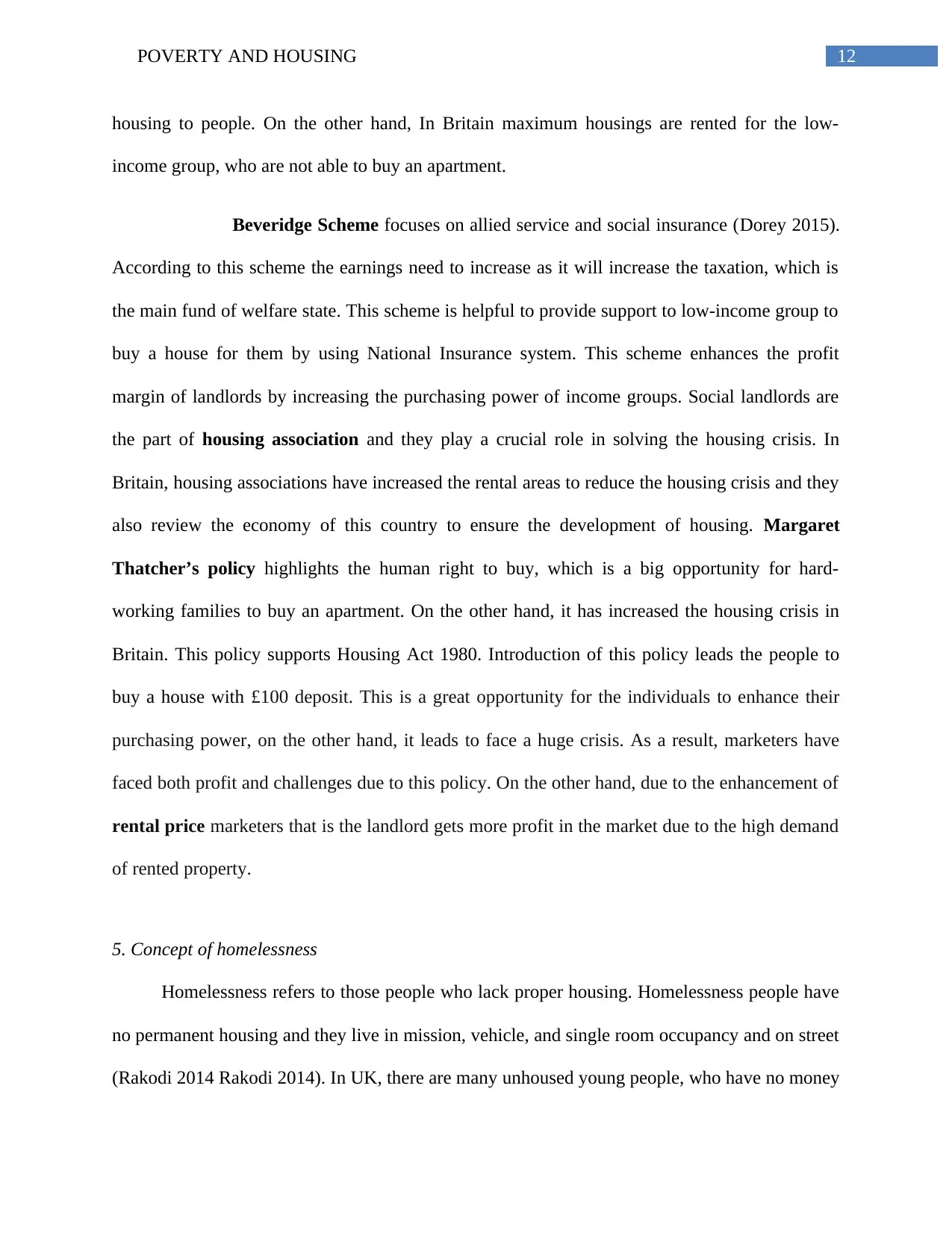
12POVERTY AND HOUSING
housing to people. On the other hand, In Britain maximum housings are rented for the low-
income group, who are not able to buy an apartment.
Beveridge Scheme focuses on allied service and social insurance (Dorey 2015).
According to this scheme the earnings need to increase as it will increase the taxation, which is
the main fund of welfare state. This scheme is helpful to provide support to low-income group to
buy a house for them by using National Insurance system. This scheme enhances the profit
margin of landlords by increasing the purchasing power of income groups. Social landlords are
the part of housing association and they play a crucial role in solving the housing crisis. In
Britain, housing associations have increased the rental areas to reduce the housing crisis and they
also review the economy of this country to ensure the development of housing. Margaret
Thatcher’s policy highlights the human right to buy, which is a big opportunity for hard-
working families to buy an apartment. On the other hand, it has increased the housing crisis in
Britain. This policy supports Housing Act 1980. Introduction of this policy leads the people to
buy a house with £100 deposit. This is a great opportunity for the individuals to enhance their
purchasing power, on the other hand, it leads to face a huge crisis. As a result, marketers have
faced both profit and challenges due to this policy. On the other hand, due to the enhancement of
rental price marketers that is the landlord gets more profit in the market due to the high demand
of rented property.
5. Concept of homelessness
Homelessness refers to those people who lack proper housing. Homelessness people have
no permanent housing and they live in mission, vehicle, and single room occupancy and on street
(Rakodi 2014 Rakodi 2014). In UK, there are many unhoused young people, who have no money
housing to people. On the other hand, In Britain maximum housings are rented for the low-
income group, who are not able to buy an apartment.
Beveridge Scheme focuses on allied service and social insurance (Dorey 2015).
According to this scheme the earnings need to increase as it will increase the taxation, which is
the main fund of welfare state. This scheme is helpful to provide support to low-income group to
buy a house for them by using National Insurance system. This scheme enhances the profit
margin of landlords by increasing the purchasing power of income groups. Social landlords are
the part of housing association and they play a crucial role in solving the housing crisis. In
Britain, housing associations have increased the rental areas to reduce the housing crisis and they
also review the economy of this country to ensure the development of housing. Margaret
Thatcher’s policy highlights the human right to buy, which is a big opportunity for hard-
working families to buy an apartment. On the other hand, it has increased the housing crisis in
Britain. This policy supports Housing Act 1980. Introduction of this policy leads the people to
buy a house with £100 deposit. This is a great opportunity for the individuals to enhance their
purchasing power, on the other hand, it leads to face a huge crisis. As a result, marketers have
faced both profit and challenges due to this policy. On the other hand, due to the enhancement of
rental price marketers that is the landlord gets more profit in the market due to the high demand
of rented property.
5. Concept of homelessness
Homelessness refers to those people who lack proper housing. Homelessness people have
no permanent housing and they live in mission, vehicle, and single room occupancy and on street
(Rakodi 2014 Rakodi 2014). In UK, there are many unhoused young people, who have no money
⊘ This is a preview!⊘
Do you want full access?
Subscribe today to unlock all pages.

Trusted by 1+ million students worldwide
1 out of 16
Related Documents
Your All-in-One AI-Powered Toolkit for Academic Success.
+13062052269
info@desklib.com
Available 24*7 on WhatsApp / Email
![[object Object]](/_next/static/media/star-bottom.7253800d.svg)
Unlock your academic potential
Copyright © 2020–2025 A2Z Services. All Rights Reserved. Developed and managed by ZUCOL.




